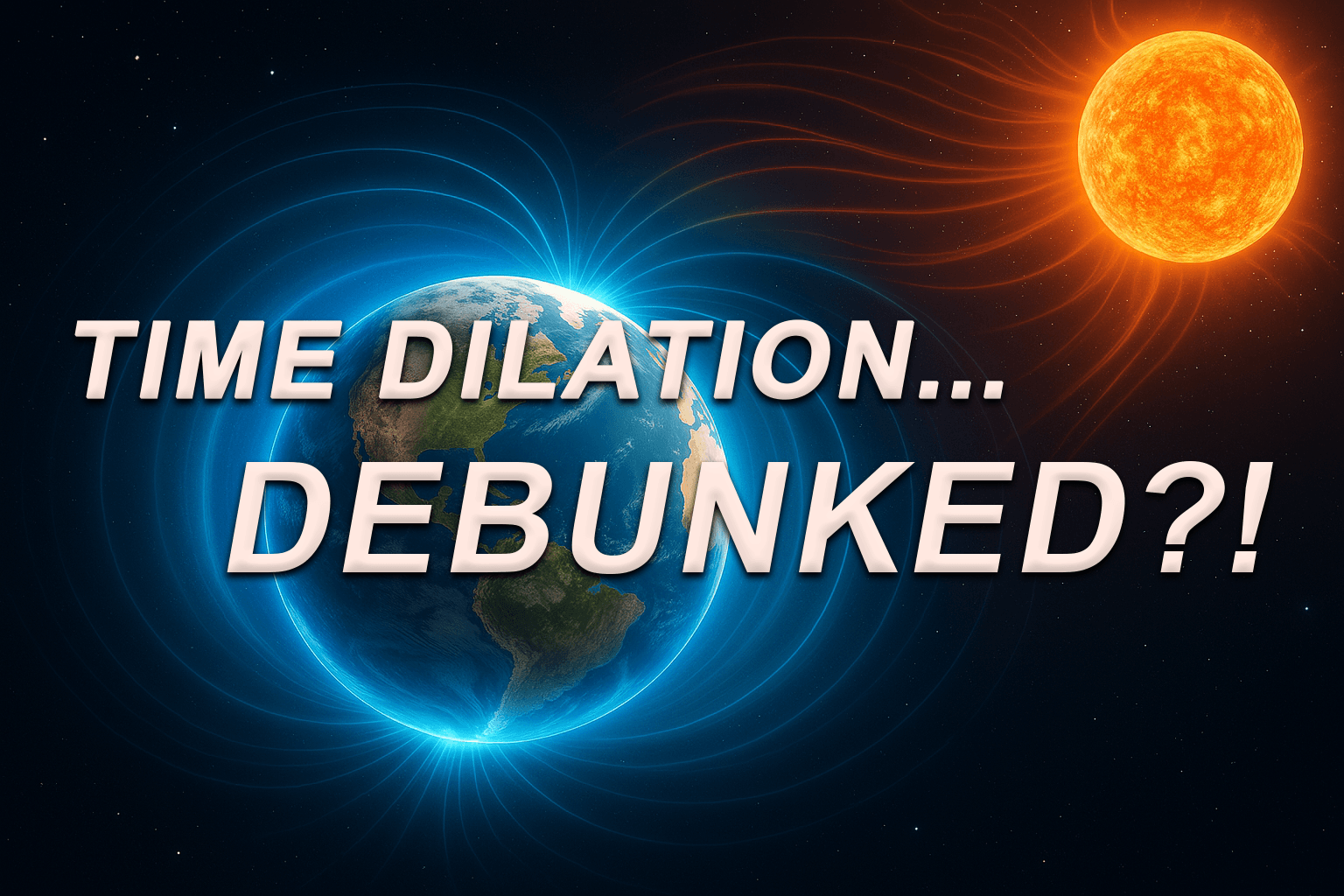Why Time Doesn’t Bend—and How Wave Pressure Explains Clock Drift Without Spacetime
Introduction: The Clock Drift Mystery
For over a century, physicists have claimed that time itself can slow down. According to Einstein’s theory of relativity, the faster you move—or the deeper you fall into a gravitational field—the slower time flows for you. This prediction, known as time dilation, is said to be confirmed by everything from high-speed particle experiments to GPS satellites. But what if this widely accepted explanation is wrong?
Acoustic Gravitic Theory (AGT) proposes a mechanical alternative: clocks do not slow down because time bends—they slow down because the oscillator inside the clock is immersed in a dense wave field. The frequency shift we observe is not a distortion of time itself, but the result of resonant drag—the interference of coherent pressure waves with the internal dynamics of oscillatory systems.
This article dismantles the assumption that time is elastic and repositions time dilation as a wave-interaction phenomenon, grounded in measurable physics—not spacetime geometry.
The Einsteinian Explanation—and Its Problem
Einstein’s theory of Special Relativity predicts that moving clocks tick more slowly than stationary ones. The effect is described by the Lorentz factor:
This formula leads to the idea that time literally “slows down” for fast-moving observers. General Relativity extends this further, claiming that clocks deeper in a gravitational well tick more slowly than those at higher elevations due to spacetime curvature. The deeper the well, the stronger the effect.
But here’s the catch: relativity provides no physical mechanism for this stretching of time. It asserts that time is relative, but cannot describe why clocks would slow, aside from coordinate transformations. This leaves the door wide open for alternative explanations rooted in material interaction.
Reclaiming Lorentz: Not Time, but Medium Compensation
Before Einstein, Hendrik Lorentz had already proposed the transformations that relativity would later adopt. But Lorentz’s intent was not to bend time—it was to preserve the wave structure of Maxwell’s equations in a medium that was assumed to be undetectable (the aether). His transformations were a mathematical compensation, not a metaphysical revision of time.
AGT picks up where Lorentz left off, maintaining that a real medium exists—not an aether, but a plasma-rich, oscillatory field that fills both Earth’s atmosphere and space. This medium exerts pressure-based resistance on oscillatory systems. When a system moves into a different field condition—such as a lower-pressure region in orbit—it undergoes a resonant frequency shift, not because time stretches, but because the mechanical conditions around the oscillator have changed.
The AGT Explanation: Resonant Drag, Not Time Dilation
Clocks are not measuring time—they are counting oscillations. Cesium-133 clocks, for instance, use a hyperfine transition at:
In AGT, this frequency can shift based on how the oscillator couples to its local wave field. The oscillator is phase-locked to ambient infrasonic and electromagnetic pressure fields. When immersed in denser wave environments, phase lag increases, causing the oscillator to slow. This produces:
Where:
- f 0 = intrinsic oscillator frequency
- Δf (P) = phase delay due to ambient pressure field
The concept is simple: oscillators are dampened by pressure, much like a guitar string in fog or a pendulum in water. Less resistance allows faster oscillation.
GPS Satellites: The Decoupling Effect
GPS satellites travel at ~11,000 mph in orbits about 20,200 km above Earth. Their clocks tick faster than those on the ground—by about 38 microseconds per day, which must be corrected for GPS to remain accurate.
Relativity claims this is due to both speed (slowing the clock) and altitude (speeding it up via gravitational time dilation). But AGT offers a cleaner, causal model:
- Earth’s atmosphere and surface are embedded in a high-pressure infrasonic field, maintained by ELF/ULF resonance and seismic-acoustic feedback.
- Satellites orbit in low-pressure plasma (e.g., ~0.01 Pa), where infrasonic coherence is nearly absent.
- The cesium oscillator on the satellite is decoupled from the Earth’s scalar wave shell.
This field detachment reduces resonant drag, allowing the clock’s oscillator to tick at its unloaded frequency—thus appearing to “run fast.”
The Math Behind the Match: AGT vs Einstein
AGT models the frequency shift using a scalar pressure field ratio:
Where:
- γ = oscillator coupling constant (solved empirically)
- Psurface = 101,325 Pa (sea level)
- Porbit ≈ 0.01 Pa (from Parker Solar Probe and THEMIS data)
- k (linear scaling)
Solving this using observed GPS drift (4.0431 Hz/day) gives:
When plugged back in:
Perfect match. No spacetime needed.
Experimental Pathways
AGT offers testable predictions:
- Phase-Cancellation Weight Tests
Suspend a test mass in a chamber and emit a 180° inverted infrasonic wave. A measurable reduction in gravitational force would confirm wave-based pressure effects. - Clock Drift at Controlled Altitudes
Place synchronized cesium clocks at different elevations with pressure-controlled shielding. Measure oscillator deviation without any velocity component. - Solar Storm Clock Disruption
Monitor cesium oscillator drift during geomagnetic storms. Increased ELF activity should increase drag, slowing the clock—without any change in gravity or velocity.
These experiments distinguish resonant drag from coordinate dilation—proving that AGT can replace relativity with physical causation.
Conclusion: The Time Dilation Illusion
Time doesn’t bend.
Clocks don’t stretch.
Oscillators don’t warp reality.
They just vibrate differently in different field environments. AGT recovers Lorentz’s original insight—that motion and field detachment affect wave-based systems—not the flow of time itself.
Time dilation is not a property of spacetime.
It is a property of oscillators in resonant media.
And now, with matched empirical predictions and a mechanical cause, AGT doesn’t just compete with Einstein—it replaces him.
References
Alfvén, H. (1942). Existence of electromagnetic-hydrodynamic waves. Nature, 150(3805), 405–406. https://doi.org/10.1038/150405d0
Bedard, A. J., & Georges, T. M. (2000). Atmospheric infrasound. Physics Today, 53(3), 32–37. https://doi.org/10.1063/1.882863
Bjerknes, V. (1906). Fields of force. Leipzig: B.G. Teubner.
Available at HathiTrust: https://catalog.hathitrust.org/Record/000432214
Bridgman, P. W. (1927). The logic of modern physics. New York, NY: The Macmillan Company.
Available at Internet Archive: https://archive.org/details/logicofmodernphy00bridrich
Einstein, A. (1905). On the electrodynamics of moving bodies. Annalen der Physik, 17, 891–921. https://einsteinpapers.press.princeton.edu/vol2-trans/154
Lorentz, H. A. (1904). Electromagnetic phenomena in a system moving with any velocity less than that of light. Proceedings of the Royal Netherlands Academy of Arts and Sciences, 6, 809–831. https://en.wikisource.org/wiki/Electromagnetic_phenomena_(Lorentz)
Michelson, A. A., & Morley, E. W. (1887). On the relative motion of the Earth and the luminiferous ether. American Journal of Science, 34(203), 333–345. https://www.aip.org/history-programs/niels-bohr-library/exhibit/michelson-morley-experiment
Van Flandern, T. (1998). The speed of gravity—What the experiments say. Physics Letters A, 250(1–3), 1–11. https://doi.org/10.1016/S0375-9601(98)00850-1

